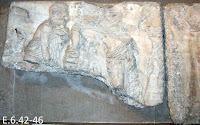The frieze of the Parthenon is a continuous band of sculpture in low relief which ran 11.9 metres (39 ft) above the pavement of the colonnade round the outer wall of the cella. The length of the frieze was 159.42 metres (522 ft. 8 in.) and 1 metre (3 ft 3.95 in.) high. 21.18 metres (69.5ft) covered each of the narrower front and back walls (east and west) and 58.53 metres (191.9ft) decorated each of the longer walls (north and south) of the rectangular building. Originally it consisted of 115 panels, ninety-four of which still exist, either intact or broken. Thirty six are in Athens (50 metres), fifty-six are in the British Museum (80 metres) and one is in the Louvre.
"The most widely held opinion about the subject of the frieze (442-438 B.C) is that it represents the procession that took place at the time of the Greater Panathenaia. As has long been recognized, however, what we see represented on the frieze does not correlate very well with what ancient authors tell us about the components of the procession. The figures who bear hydriai, for example, should be women (not men as they are on the frieze); the kanephoroi (basket bearers) are omitted; and most troubling of all, there are no trace of the Athenian infantry, the hoplites, even though a contemporary source, Thucydides [6.58] implies that they should be there." (The Meaning of the Parthenon Frieze, J.J.Pollitt in Studies in the History of Art, Vol. 49 (1997) pp.50-65)
I concur with Professor Pollitt's conclusion that the frieze has little or nothing to do with the procession."Thus the slab remained for about thirteen centuries detached from its place on the Akropolis" (The Newly Discovered Head of Iris, C. Waldstein, American Journal of Archaeology, vol. 5, 1889)
East Frieze (in the British Museum)
























